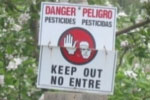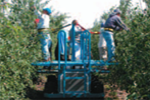Spraying, Tree Care
Orchard Spraying Facts: Orchard spraying falls into two classes:
- tree spraying for disease and pest control, nutrition, growth regulation, and chemical thinning
- ground spraying for weed control
Major components:
- A mixer/loader measures, weighs out pesticides into the measurement containers and pours the pesticide into the tank. They may also add pressured packets of pesticides.
- Applicators drive and operate the tractors and sprayers.
- Depending on the orchard, the tasks of mixing/loading and applying may be conducted by different handlers or one handler may do both.
- Pesticide handlers must have a Private Applicator License or be supervised by someone with the license.
- All agricultural workers and pesticide handlers must receive EPA Worker Protection Standard (WPS).
- Washington State has its own WPS that has additional requirements beyond the Federal WPS.
- Washington State has a regulation monitoring cholinesterase levels in handlers of orgahophosphorus and certain carbamate pesticides.
- Pesticide handlers are to wear the appropriate PPE as per the pesticide label.
- Licensed pesticide handlers are trained on how to read the pesticide labels, handle pesticides, apply pesticides, safety, and disposal.
- Handlers can take the License exam through WSDA
- Study materials are available WSU Cooperative Extension
- WSDA provides English and Spanish classes in pre-license training, recertification, WPS train-the-trainer, and WPS Hands-on Handler training.
- WA State Department of Labor & Industries and WA State Department of Agriculture enforces regulations that protect employees from pesticide exposure.
 Spraying, chemical contact
Spraying, chemical contact Tractor and Machinery Hazards
Tractor and Machinery Hazards